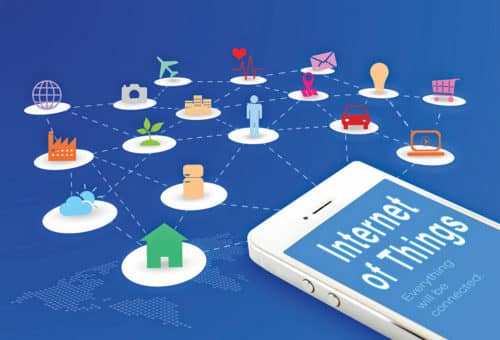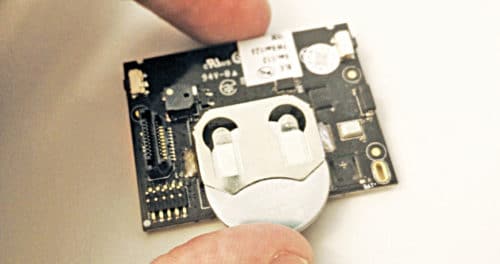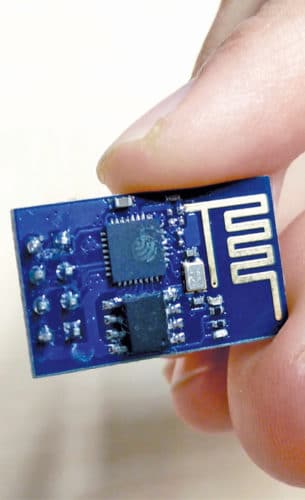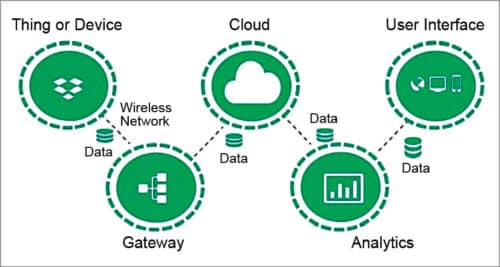A quick guide to designing a perfect Internet of Things (IoT) system taking into account performance, connectivity, power consumption and security issues
The Internet of Things (IoT) is no longer a technology of the future. Smart cities, connected industries and smart households have indeed ushered in an era where machines can communicate. The beauty of this technology lies in the fact that the complex backend structure of systems is represented to the end-user in the simplest possible form. This requires profound design know-how.
What the IoT is made up of
The IoT can be designed at different scales for different uses. It can start from our homes with simple lighting or appliance control, and expand into the realm of factories and industries with automated machines, smart security systems and central management systems—called connected factories. It has scaled up to entire cities with smart parking, smart metering, waste management, fire control, traffic management and any similar functions involved. However, irrespective of the scale of application, the main IoT backbone remains similar.
The IoT architecture is multi-layered with delicate components intricately connected to each other. It starts with sensors, which are the source of data being collected. Sensors pass data onto an adjacent edge device, which converts data into readable digital values and stores these temporarily. When the edge senses a suitable wireless network or the Internet, it pushes the locally stored data to a cloud server involved in the application. The data is processed, analysed, stored and forwarded to the end-user device, represented by an application software. All the design fundamentals and challenges revolve around these layers.

Designing the perfect system
Successfully setting up a complete IoT chain comes with certain challenges. Designers need to walk the extra mile to meet all business requirements like prolonged battery life and low power consumption, secured network gateways, ruggedised hardware and more. Electromagnetic compliance (EMC) and resistance to electromagnetic interference (EMI) are also essential. Introducing new devices within a wireless radius without disturbing the existing system is one of the most demanding skills for an IoT design.
Components like the microcontroller unit (MCU), sensors and wireless network are built and handled with special care for an optimal system design. Based on the scale of application, the design is bound to alter. While basics remain the same, minute detailing into engineering improves a system build by leaps and bounds.
Optimising the MCU
An MCU is the central nervous system of the IoT setup. Data collected by sensor nodes is processed by the MCU using software programs, enabling the system to respond accordingly. The MCU for an IoT system is chosen based on application-specific requirements.
For basic applications with limited amount of data to be transmitted every day, an 8-bit MCU will suffice. On the other hand, large-scale connected systems require 32-bit controllers. As 32-bits MCUs have a bigger RAM size and larger flash that can hold a complete network stack and application codes, these are optimal for embedded systems that will apply radio-frequency (RF) program stacks or complex algorithms.
According to Kavita Char, formerly senior product manager at Silicon Labs, MCUs with floating-point units (FPUs) have further compatibility for such applications and ease the computation process. An FPU-supported controller enables precision up to long decimal values. This gives a lot of flexibility in data calculation and eliminates the requirement of overflow-checks in the program.
MCUs with FPUs can be of great advantage in applications like location tracking, processing of measurement data from accelerometers and gyrometers, or any application where data precision is quite important.
Designing the connectivity module
How would you want your devices to interact? At the moment, major wireless options include Wi-Fi, Bluetooth Low Energy (BLE), GSM and Zigbee. Designers need to pay attention to some essential criteria for choosing a connectivity module. Some of these factors include data throughput, connectivity range and speed required, power requirement, scalability, robustness and upgraded protocol. Designers must choose a technology that will survive the test of time.
Building an effective connectivity model depends on two components: transceiver of the module (which essentially consists of a receiver, a transmitter and an antenna) and network frequency.
The receiver of a transceiver sets the threshold for the signal to be received and also ensures that the signal is distinguishable from the other signals in the same frequency and the ambient noise. Therefore ensuring a high-quality receiver is imperative. Lower data rate improves sensitivity of the receiver.

The transmitter, on the other hand, controls the output power of the transceiver—how much it can amplify. Experts suggest a 6dB gain capacity can double the amplitude of the output signal. While higher transmitter power means higher output signal, there is a trade-off in battery life. Hence this decision should depend completely on the type of application, the data to be amplified and the geographic location.
Now let’s talk about the frequency, which determines the range and data-throughput capacity. For IoT applications, sub-1.0GHz and 2.4GHz are the most used frequency ranges. Unlike the large data flow during media streaming or voice/video calls, IoT applications are associated with small data packets.
Now, many developers opt for 2.4GHz frequency range owing to its popularity in mainstream applications. This frequency range does provide higher data throughput capacity but not without challenges. First, the 2.4GHz array has a lower range of coverage and poor penetration through obstacles. More importantly, this frequency has a heavy traffic of data packets coming from other devices like microwave ovens and Wi-Fi devices. This creates the problem of signal interference.

Sub-1.0GHz range, on the other hand, offers greater coverage range and sensitivity in lieu of data volume throughput. Distributed infrastructure can greatly benefit from its long-range characteristics. Moreover, data transmission through obstacles is possible.
Char suggests, “Since sensors of an IoT system generate small data throughout the day, sub-1.0GHz frequency is suited for most applications as it consumes much less power and provides connectivity for years on a battery.”
For instance, IoT systems in agricultural fields or oil and gas industries will share very low-volume data such as soil pH, moisture level and gas level. A sub-1.0GHz frequency can efficiently cover the complete perimeter while consuming much less power.
Coming to wireless standards, while 802.11ac is the most popular Wi-Fi standard in the market, a newer iteration called IEEE 802.15.4 is gaining prominence for the IoT.
Creating a power-efficient system
For IoT applications, designers need to focus on power requirements. Batteries used in these systems are expected to last up to 20 years without requiring much manual intervention. The uniqueness of IoT design elements is their ability to sleep when not in use.
Gaurav Sareen, country head-India, Sigfox, explains, “The transceiver wakes up only when it is supposed to transmit data. As soon as it is done, it goes back to sleep. So, the hardware is essentially asleep most of the time. That is how it conserves energy.”
IoT systems consume power in two modes: dynamic (when the hardware is active) and static (when the hardware is asleep or in standby mode). It is essential to keep these factors in check. Consumption of both the MCU and the transceiver are considered. 32-bit MCUs can transmit data faster. Therefore their dynamic consumption can be much less, enabling the chip to save more energy. FPU compatibility further enhances efficiency. Large-scale applications in businesses can greatly benefit from FPU-supported MCUs.

Software for security
Security solutions are essential to ensure that no part of the system (hardware, software or network gateway level) is compromised.
Sareen mentions, “Secure Elements (SE) are in use to ensure safety at hardware level. An SE itself is an additional hardware component that encrypts data and checks authenticity of the device receiving it. The network layer is secured by hiding the data in motion with advanced encryption schemes (AES). Data cannot be breached while being transmitted through network gateways. Finally, data itself is tested in the application layer to ensure it is infection-free.” Authentication levels, including passwords and biometrics, provide secured access to all components and data. In addition, there are debug software that ensure proper functioning of the IoT system.
Why it’s the best time to Design IoT Systems
The job of designers is becoming even simpler with manufacturers introducing integrated modules like MCU-cum-transceiver units that facilitate quicker IoT system design. Efficient software tools allow speedy programming of embedded systems. With improved technology and capacities, isn’t this the best time to be an IoT designer?







This is amazing. I discovered your 1001+Electronics Projects For You through engine search and as a subscriber I would like to improve my DIY with it. Please let me have a copy. I will be glad to know the cost through my contact detail I am a retired Chartered Engineer and this your amazing book will keep me busy.
Thank you
Robert Odigie